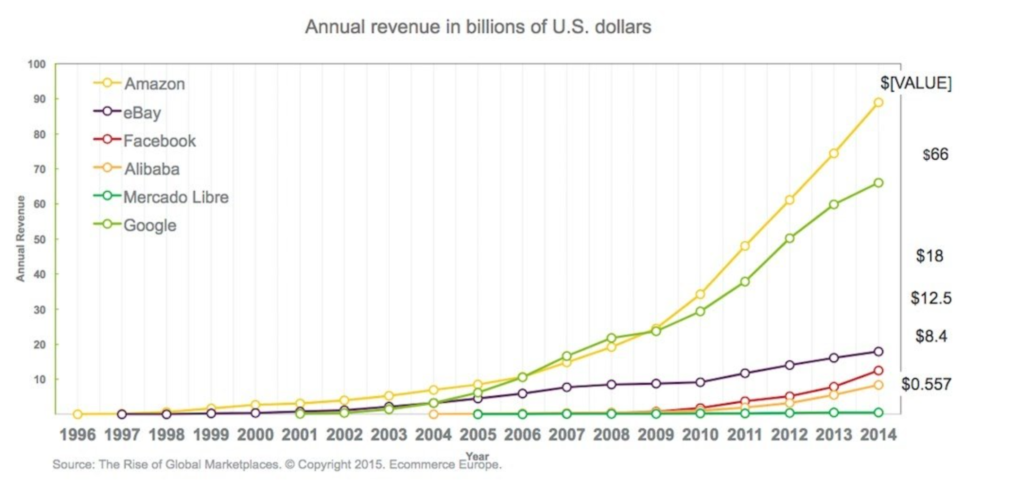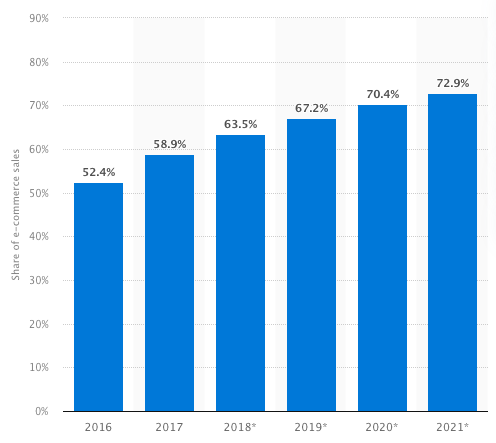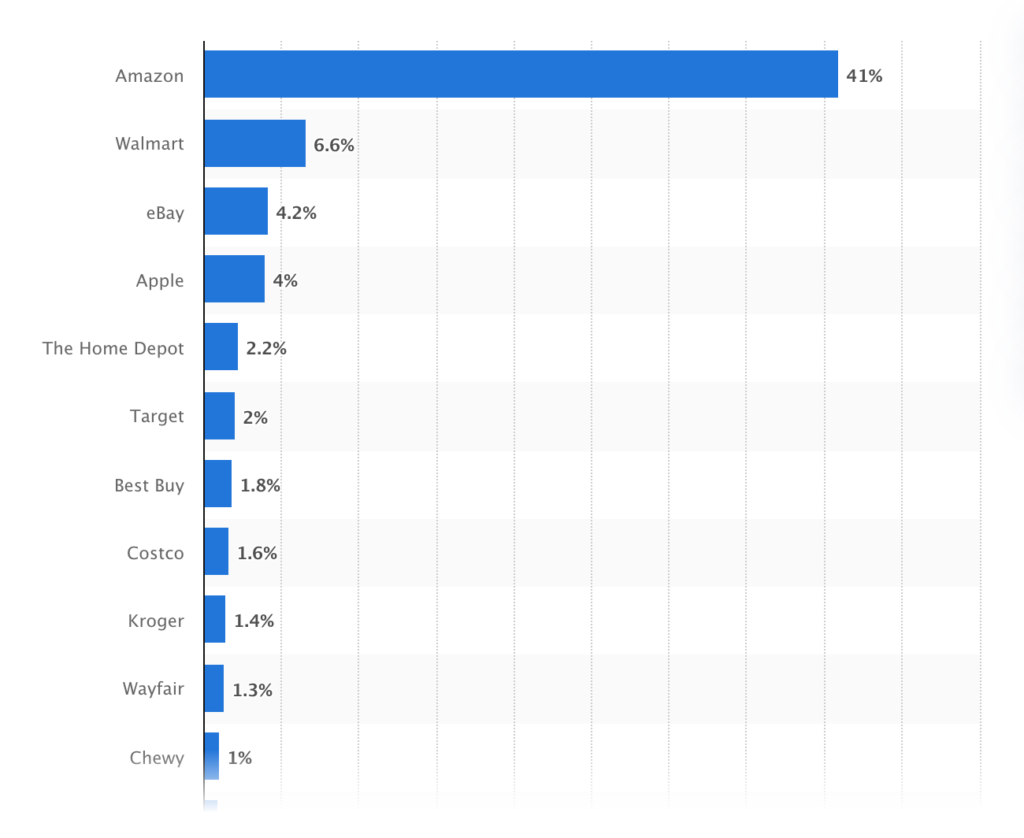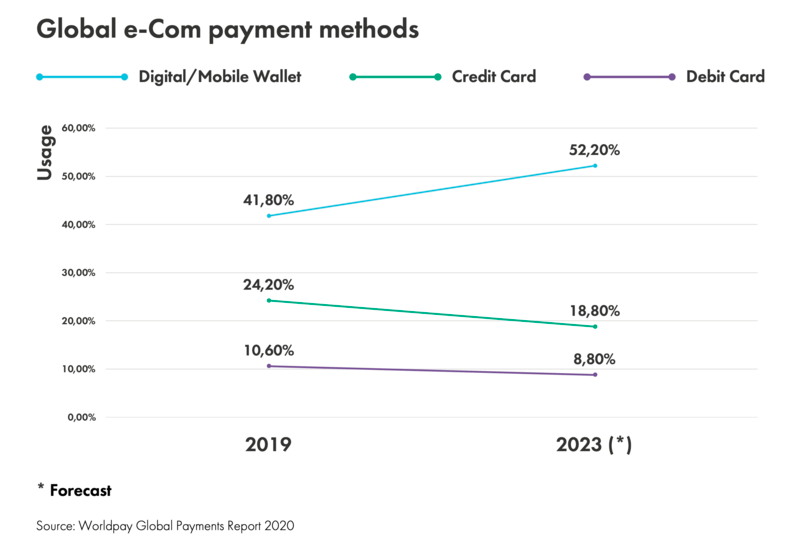Introducing installment two in our Vertical Deep Dive Series, where we examine the inception, growth and decline points, and other major trends in each of the top verticals in mobile, such as mobile ecommerce trends. In our latest feature, we'll explore the success of eCommerce and specifically how it was transformed by mcommerce trends in recent years. We'll begin with the inception of eCommerce 40 years ago, and discuss how the smartphone, social media, and the internet have driven the growth of eCommerce.
The ongoing digitalization of the modern world has transformed eCommerce in recent years. With the number of digital buyers climbing year over year, it is no surprise that eCommerce is on the rise. One of the most significant and visible mobile ecommerce trends is the purchasing of products through mobile devices. Significantly, mobile commerce has largely driven the most recent surge of growth. Mobile commerce is estimated to make up 73% of all eCommerce sales in 2021; while in 2016, it accounted for 52.4% of eCommerce sales. In this piece, we will explore the history of eCommerce and learn how digital transformation has allowed the mobile platform to become the main driver of trending mCommerce growth in recent times.
History of E-Commerce & Mobile E-Commerce Shopping Trends
In its earliest form, eCommerce was introduced almost 40 years ago. In 1979, English inventor and entrepreneur Michael Aldrich invented “teleshopping” to enable online transaction processing. He did so by connecting a modified TV to a transaction-processing computer via a telephone line. Unsurprisingly, the technique did not become economically viable until it was enabled by the internet.

In 1995, Jeff Bezos launched Amazon as an eCommerce platform primarily for books. Three years later, PayPal launched as the first eCommerce payment system. Fast forward to 2017, and a Shoppable Instagram was introduced. This enabled social media users to purchase items by clicking on an ad and being transported directly to the product page. Later that year, Cyber Monday sales broke $6.5 billion in the US, setting a new record and exceeding the previous year’s sales by 17%.
E-Commerce has certainly come a long way since 1979. The birth of the internet, smartphone, and social media have aided in the unprecedented growth experienced in the eCommerce industry, with m-Commerce trending to become its main driver. Now that we know how eCommerce began, let’s explore the current mobile eCommerce trends that allow it to thrive in modern times.
Current E-Commerce and Mobile eCommerce Trends

Source: Statista
E-Commerce is rising extraordinarily year over year, and is expected to reach an astounding $6.38 billion by 2024. The number of digital buyers continues to climb as modern life becomes more digitized. The result is an ever-changing retail landscape that brings the shopping experience to digital users’ fingertips. A large contributor to the growth of the digital shopping experience has to do with mCommerce trending upward, which has boosted eCommerce traffic and accounted for almost 70% of all retail website visits worldwide.
Leading Retail eCommerce Companies in 2021

Source: Statista
Amazon continues to top the charts 26 years after its initial launch, accounting for 41% of the US eCommerce market, as well as the most popular mobile Shopping app as of October 2021. Walmart, eBay, Apple, and Home Depot represent the rest of the top 5 retailers in US eCommerce market share. This combination of eCommerce categories represented—including B2B, B2C and C2C— shows the diversity of eCommerce strategies that prove successful today.
The Social Commerce Buzz
In 2020, the global social media penetration rate climbed to 69% in North America, 71% in East Asia, and 67% in Northern Europe. As social media has continued to become more ingrained in modern life, the trend of mobile eCommerce has increased. Instagram and Facebook have become big players in social commerce. These social media sites offer users the opportunity to buy products directly from social media sites. Strategies such as providing personalized shopping experiences and one-click shopping options have dramatically transformed the digital shopping experience. In fact, these techniques are highly significant to the overall success of omni-channel shopping.
An Omni-Channel Shopping Experience
The explosion of trending mCommerce gives retailers new ways to reach consumers. By selling through multiple channels, retailers can create a personalized, consistent user experience that improves the overall customer journey. With so many digital channels for users to explore, retailers have the power to put their brands on the map, build trust with their consumers, and increase purchases. In building an omni-channel shopping strategy, creating consistency and personalization across different channels is crucial to mobile marketing success. Furthermore, segmentation can allow retailers to target users based on behavioral and demographic data. This mobile ecommerce trend is powerful, and can result in a more cohesive user journey that is targeted and personalized, paving the way for eCommerce brands.
Future E-Commerce and Mobile E-Commerce Trends
With social media, multi-channel marketing, and digital transformation at the forefront of eCommerce growth, let’s examine the future trends that will allow retailers to take advantage of the modern shopping experience.
M-Commerce Trend 1: Time Spent on Mobile Devices Rising
Mobile commerce sales are projected to reach $3.56 trillion in 2021. This represents a 22.3% increase from the previous year in which mobile commerce sales reached $2.91 trillion. This upward trend is congruent with the increasing total time spent on mobile devices, which is also on the rise, with a 24.5% increase between 2016 to 2021. The increasing time people spend on their mobile devices has coincided with a boom in mobile shopping. As the amount of time mobile users spend on their smartphones continues to increase, time spent in apps will likely increase, including time spent in eCommerce apps.
M-Commerce Trend 2: The Mobile Wallet

Source: Worldpay Global Payments Report 2020
The mobile wallet allows users to tap or scan their mobile device in order to pay for goods and services. Digital wallets have greatly contributed to the ease of which users can complete transactions. This has led to an overall increased demand for frictionless experiences. Furthermore, the digital transformation of the internet and smartphones has led to an increase in digital payments. The digital wallet accounted for 41.8% of global eCommerce transaction methods in 2019, and this number is expected to increase to 52.2% by 2023. Currently trending in the mobile eCommerce world, using a digital wallet to purchase an item can transform the checkout experience, making it easier than ever to purchase products.
M-Commerce Trend 3: The Portable & Personalized Shopping Experience
The portability of mobile devices gives businesses the opportunity to reach consumers when they are on-the-go. A consumer can now access a retailer’s items anywhere in the world and at any time. This direct connection with consumers can boost a retailer’s visibility and direct consumer connection. As mCommerce continues to trend in total eCommerce growth, it is critical that retailers take advantage of the direct connection to consumers. Focusing their strategies on increasing engagement and retention is now a major priority.
To do so, retailers must focus on enhancing the user experience, and making it as targeted as possible. Through dynamic creative optimization (DCO), retailers can offer personalized shopping experiences to their users. One method includes location tracking via GPS which can help mobile users digitally find items that they perused in-store. Another is offering algorithmically optimized creatives which target users based on their personal interests and demographic. These strategies, along with others — such as targeted push campaigns and dynamic segmentation —are crucial for retailers to capitalize on the booming growth of mobile commerce.
Mobile E-Commerce Trend Takeaways
The trending rise in mCommerce shows no signs of slowing down as the modern world continues being transformed by digital innovation. Here, we take a look at the history of eCommerce, and discover the role digital transformation has played in allowing the mobile platform to become the main driver of eCommerce growth in recent times.
- Originally invented in 1979, eCommerce has certainly come a long way in the last 40 years. There are many contributions that have led to the unprecedented growth of the eCommerce sector. Most significantly, the birth of the internet, smartphone, and social media.
- Mobile commerce has boosted eCommerce traffic and accounted for almost 70% of all retail website visits worldwide. The explosion of mobile commerce gives retailers new ways to reach consumers, create brand awareness, build trust, and increase purchases.
- Mobile commerce sales are projected to reach $3.56 trillion in 2021, a 22.3% increase since 2020. As mobile commerce continues to explode, it is critical that retailers take advantage of the direct connection to consumers. Now is the time to focus efforts on building eCommerce strategies to increase user engagement and retention.
Ready to Act on m-Commerce Trends?
Need help staying ahead of the mobile eCommerce trends ? YouAppi can help you engage and re-engage users to reduce cart abandonment and increase purchases. Contact us today to get started!

